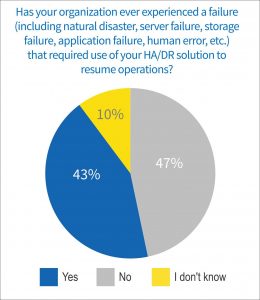 INFRA
INFRA
 INFRA
INFRA
 INFRA
INFRA
Digital transformation is high on the agenda for many organizations today, but it turns out a lot of them are doing things the same old way when it comes to keeping the lights on and the engines running.
A joint survey of more than 5,600 information technology professionals across the globe by software vendors Syncsort Inc. and its Vision Solutions Inc. subsidiary found that few organizations are tapping into new technologies to improve IT resilience. Despite the availability of a variety of new cloud-based backup and disaster recovery services, most organizations are still using on-premises equipment and managing backup with their own staffs. Migrations are similarly coordinated internally, with the result being that a significant minority of respondents have experienced a failed migration project within the past year.
The “2018 State of Resilience” survey covers availability, security, migration, data sharing and cloud computing. Responses came from people at nearly all levels of the IT organization and in every major geographic region. The broad dispersion of titles and regions means that the findings contrast in some areas with research by the chief information officer-focused reports of big consulting and analyst firms. For example, when asked about the benefits of cloud computing, more respondents cited “eliminates requirement to own data center resources” than any other choice, follow by “operational cost savings” and “IT capacity on demand.” In contrast, senior executives typically identify business agility and speed as the most compelling benefits of cloud.

Source: Syncsort
Respondents identified the top technology initiatives for the next two years as IT security, closely followed by availability and cloud computing. Concerns about cloud security remain high. It was the the No. 1 security challenge, cited by 43 percent of respondents.
Yet organizations aren’t apparently investing in new technologies to combat these threats. The four biggest security investment areas the survey identified are venerable favorites like virus protection, malware protection, patch management and intrusion detection. User training, which is often cited as the single most effective tool an organization can wield to boost its resilience, came up 14th on the list, just ahead of “self-service password reset.”
Perhaps that’s because respondents indicate a high level of confidence in the quality of their security programs. Nearly nine in 10 said they’re confident or very confident in the effectiveness of their security measures. In contrast to other research that has claimed that breaches are out of control, only 12 percent of respondents reported a breach during the last year.
One of the consequences of a cyberattack is downtime, and in this area respondents indicated that their practices have evolved little over the last few years. The primary technology used for data protection is hardware/storage replication, cited by 53 percent of respondents. That’s followed closely by tape backup and software-based replication.
Those mature technologies don’t appear to be working so well. Nearly half of respondents said their business has experienced a failure that required the use of backup, and a third of that group lost data. Of those that lost data, 31 percent lost a day or more. The primary reasons: old backup copies, human error or failure to back up data in the first place.
Only 22 percent of IT pros said their company uses disaster recovery as a service, and just 10 percent apply electronic vaulting. Both are considered simpler and more effective than tape backups, but old habits evidently die hard. Interestingly, midsized companies show the best resilience. Their downtime averaged eight hours per incident, whereas at large and small companies it was 11 hours.
Despite concerns about cloud security, 83 percent of respondents said their company has adopted a cloud model. Private clouds are most popular, followed closely by hybrid and public clouds. Nearly 40 percent of respondents said they use the cloud for mission-critical applications. Nearly half use two or more cloud types and 22 percent use three or more.
THANK YOU